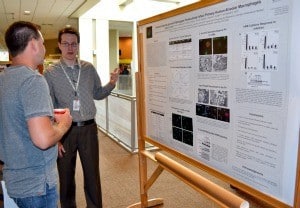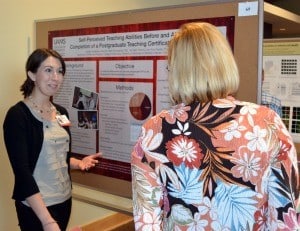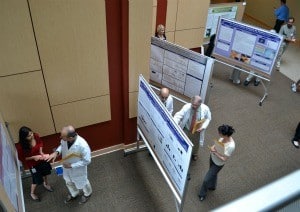UAMS Students Display Research Work
| April 17, 2012 | Nearly 100 graduate students displayed research posters and discussed their work with peers and UAMS faculty as part of the annual Student Research Day on April 10. The campus event provided an opportunity for students and research advisors to interact with student investigators from other colleges. Faculty members and students mingled during morning and afternoon poster sessions, asking questions of the student investigators. The research included projects that have been or will be presented at national conferences. Joseph Graham, a student in the microbiology and immunology program, talked about his latest work analyzing the behavior of Coxiella burnettii, a bacterial pathogen. Looking at electron microscope images of the bacteria turned up an unexpected discovery, he said, drops of lipid molecules that might indicate an energy source that keeps the bacteria alive and growing. Through better understanding of the bacteria, researchers may find new pathways for therapies to stop it, he said. So what is it like to find something unexpected in the course of research? “It’s exciting and definitely interesting,” said Graham, standing in front of his poster “Virulent Coxiella burnetii Pathotypes Productively Infect Primary Human Alveolar Macrophages.” Lawrence Cornett, Ph.D., UAMS vice chancellor for research, visited with several student researchers when he walked through the afternoon poster session. “I was extremely impressed with the scientific content of the posters,” he said. “Overall, the quality of the data presented was exceptionally high and I had to keep reminding myself I was attending Student Research Day, not a major national scientific meeting.” Cornett called research a team sport and that hosting a campuswide research event promotes the team aspect. “It takes multi-disciplinary research teams to successfully address our most pressing human health problems. A research event encompassing all of the colleges and graduate school helps inspire our students to address human health problems in a multi-disciplinary fashion.” Pharmacy resident Ashley Castleberry, Pharm.D., said her project “Self-Perceived Teaching Abilities Before and After Completion of Postgraduate Teaching and Certification Program” confirmed the belief that training pharmacy instructors-to-be on teaching techniques would make them better teachers. This conclusion was found through surveys of students taking a self-assessment before and after completion of the teaching course. The survey revealed that the course was effective in preparing them to be instructors – ranging from how to create PowerPoint presentations to lecturing, she said. Castleberry and other students were eager to discuss their work with Research Day visitors, whether they were fellow students or faculty. “It’s a great chance to practice explaining your project,” said Castleberry, who wants to be a pharmacy instructor. “When faculty members talk about your work, it gives you another set of eyes to offer suggestions and give feedback.” Rinku Saha, a student in the bioinformatics program that is a joint effort of UAMS and the University of Arkansas at Little Rock, developed a workflow for statistical analysis among thousands of gene samples. For her project “Science and Workflows,” she took existing data analysis tools and developed the workflow method that found statistically significant differences in 20,000 genes in 60 separate samples. “We wanted to find a way to get faster results,” Saha said, noting the workflow was essentially a template that could be applied to different types of data for identifying differences and similarities. The posters were exhibited across two floors of the Wilson Education building. In addition the Bruce Commons in the College of Public Health building had displays and representatives from the UAMS research facility cores, where shared tools are available to researchers across all disciplines to advance their work. The day culminated with a keynote presentation by Darwin Labarthe, M.D., Ph.D., M.P.H., professor of preventative medicine in the Feinberg School of Medicine at Northwestern University entitled, “Sodium Reduction: Assessment,
|


